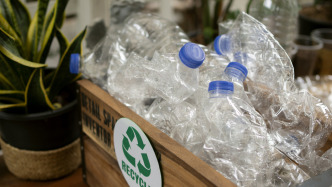
Plastic is one of the most common materials in our lives, and plastic pollution has become a pressing global issue, but there is currently a lack of comprehensive analysis of the global plastic industry. In a paper published on April 10 in the international academic journal Communications Earth & Environment, researchers segmented each type of plastic in the entire supply chain from raw materials to waste management and disposal, revealing the flow and stock status of global plastic production, use, and disposal in 2022, and drawing a global plastic trade map.
The paper said that the global plastic recycling rate has been stagnant at a low level, with a recycling rate of about 9%. In addition, of the 400 million tons of plastic produced in 2022, less than 38 million tons were produced from recycled materials, and recycled materials accounted for 9.5%.
The corresponding author of the research paper is Tan Quanyin, an assistant researcher at the School of Environment at Tsinghua University.
The research results show that the United States has the highest per capita plastic consumption, with an average of 216 kilograms of plastic consumed per person per year; China has the highest total consumption - 80 million tons per year, but China's per capita plastic consumption is significantly lower than that of the United States, with an average of 50 kilograms of plastic consumed per person per year.
In 2022, about 268 million tons of plastic were discarded worldwide, of which only 27.9% were sent for sorting and potential recycling, and only half of the sorted plastics were actually recycled. Researchers said that due to differences in regional data quality and the non-informal recycling sector, this may underestimate the global recycling rate of plastic waste. For example, there are a large number of small-scale plastic waste recyclers in China, but relevant information is difficult to be effectively counted.
Although this study does not predict trends after 2022, due to industry inertia and the demand for plastics in developing countries, the production and consumption of plastics are expected to grow, which may exacerbate the environmental challenges brought by plastic pollution. Previous studies have shown that global plastic production has increased from 2 million tons per year in 1950 to 400 million tons per year in 2022, and is expected to reach 800 million tons by 2050.
In addition, the way plastic waste is handled has also changed significantly: between 1950 and 2015, 79% of global plastic waste was landfilled, while in 2022, the proportion of global plastic waste landfilled has dropped to 40%, while incineration has risen to 34%, becoming one of the most common methods of dealing with plastic waste. Researchers call for policies that promote circular economy principles, such as reuse, reduction and recycling, to reduce plastic pollution; and emphasize the need for stricter management requirements for plastic additives, improved recycling infrastructure and improved eco-design standards to increase the recyclability of plastics and plastic products. In addition, solutions should be determined based on regional realities, such as supporting the transformation of the informal recycling sector in developing countries and promoting waste-to-energy technologies in high-income regions. In terms of plastic reduction, measures such as banning unnecessary disposable plastic products, designing recyclable products, and promoting investment in recycling systems and technologies should be taken.
Attached paper DOI: 10.1038/s43247-025-02169-5